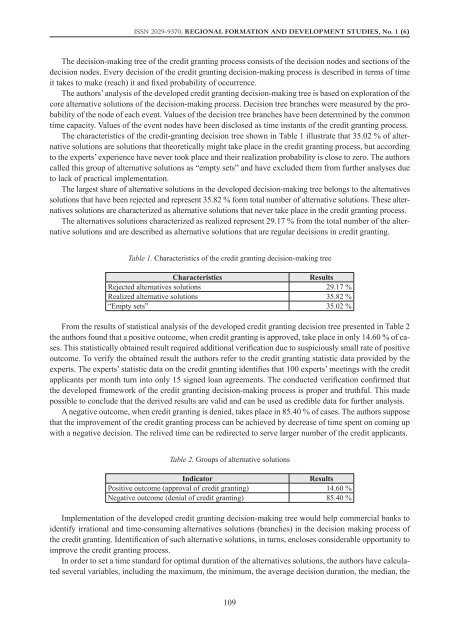Regional Formation 2012,1 - KlaipÄdos universitetas
Regional Formation 2012,1 - KlaipÄdos universitetas
Regional Formation 2012,1 - KlaipÄdos universitetas
You also want an ePaper? Increase the reach of your titles
YUMPU automatically turns print PDFs into web optimized ePapers that Google loves.
ISSN 2029-9370. <strong>Regional</strong> <strong>Formation</strong> and Development Studies, No. 1 (6)<br />
The decision-making tree of the credit granting process consists of the decision nodes and sections of the<br />
decision nodes. Every decision of the credit granting decision-making process is described in terms of time<br />
it takes to make (reach) it and fixed probability of occurrence.<br />
The authors’ analysis of the developed credit granting decision-making tree is based on exploration of the<br />
core alternative solutions of the decision-making process. Decision tree branches were measured by the probability<br />
of the node of each event. Values of the decision tree branches have been determined by the common<br />
time capacity. Values of the event nodes have been disclosed as time instants of the credit granting process.<br />
The characteristics of the credit-granting decision tree shown in Table 1 illustrate that 35.02 % of alternative<br />
solutions are solutions that theoretically might take place in the credit granting process, but according<br />
to the experts’ experience have never took place and their realization probability is close to zero. The authors<br />
called this group of alternative solutions as “empty sets” and have excluded them from further analyses due<br />
to lack of practical implementation.<br />
The largest share of alternative solutions in the developed decision-making tree belongs to the alternatives<br />
solutions that have been rejected and represent 35.82 % form total number of alternative solutions. These alternatives<br />
solutions are characterized as alternative solutions that never take place in the credit granting process.<br />
The alternatives solutions characterized as realized represent 29.17 % from the total number of the alternative<br />
solutions and are described as alternative solutions that are regular decisions in credit granting.<br />
Table 1. Characteristics of the credit granting decision-making tree<br />
Characteristics<br />
Results<br />
Rejected alternatives solutions 29.17 %<br />
Realized alternative solutions 35.82 %<br />
“Empty sets” 35.02 %<br />
From the results of statistical analysis of the developed credit granting decision tree presented in Table 2<br />
the authors found that a positive outcome, when credit granting is approved, take place in only 14.60 % of cases.<br />
This statistically obtained result required additional verification due to suspiciously small rate of positive<br />
outcome. To verify the obtained result the authors refer to the credit granting statistic data provided by the<br />
experts. The experts’ statistic data on the credit granting identifies that 100 experts’ meetings with the credit<br />
applicants per month turn into only 15 signed loan agreements. The conducted verification confirmed that<br />
the developed framework of the credit granting decision-making process is proper and truthful. This made<br />
possible to conclude that the derived results are valid and can be used as credible data for further analysis.<br />
A negative outcome, when credit granting is denied, takes place in 85.40 % of cases. The authors suppose<br />
that the improvement of the credit granting process can be achieved by decrease of time spent on coming up<br />
with a negative decision. The relived time can be redirected to serve larger number of the credit applicants.<br />
Table 2. Groups of alternative solutions<br />
Indicator<br />
Results<br />
Positive outcome (approval of credit granting) 14.60 %<br />
Negative outcome (denial of credit granting) 85.40 %<br />
Implementation of the developed credit granting decision-making tree would help commercial banks to<br />
identify irrational and time-consuming alternatives solutions (branches) in the decision making process of<br />
the credit granting. Identification of such alternative solutions, in turns, encloses considerable opportunity to<br />
improve the credit granting process.<br />
In order to set a time standard for optimal duration of the alternatives solutions, the authors have calculated<br />
several variables, including the maximum, the minimum, the average decision duration, the median, the<br />
109
















